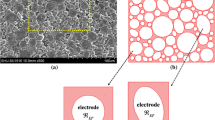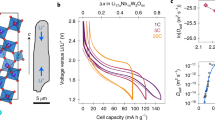Abstract
Following earlier work of Huggins and Nix [Ionics6, 57 (2000)], several recent theoretical studies have used the shrinking core model to predict intraparticle Li concentration profiles and associated stress fields. A goal of such efforts is to understand and predict particle fracture, which is sometimes observed in degraded electrodes. In this paper we present experimental data on LiCoO2 and graphite active particles, consistent with previously published data, showing the presence of numerous internal pores or cracks in both positive and negative active electrode particles. New calculations presented here show that the presence of free surfaces, from even small internal cracks or pores, both quantitatively and qualitatively alters the internal stress distributions such that particles are prone to internal cracking rather than to the surface cracking that had been predicted previously. Thus, the fracture strength of particles depends largely on the internal microstructure of particles, about which little is known, rather than on the intrinsic mechanical properties of the particle materials. The validity of the shrinking core model for explaining either stress maps or transport is questioned for particles with internal structure, which includes most, if not all, secondary electrode particles.
Similar content being viewed by others
References
R. Huggins, W. Nix: Decrepitation model for capacity loss during cycling of alloys in rechargeable electrochemical systems. Ionics657 (2000)
Y. Cheng, M. Verbrugge: The influence of surface mechanics on diffusion induced stresses within spherical nanoparticles. J. Appl. Phys.10483521 (2008)
J. Christensen, J. Newman: A mathematical model of stress generation and fracture in lithium manganese oxide. J. Electrochem. Soc.153A1019 (2006)
E. Garcia, Y. Chiang, W. Carter, P. Limthongkul, C. Bishop: Microstructural modeling and design of rechargeable lithium-ion batteries. J. Electrochem. Soc.152A255 (2005)
X. Zhang, W. Shyy, A.M. Sastry: Numerical simulation of intercalation-induced stress in Li-ion battery electrode particles. J. Electrochem. Soc.154A910 (2007)
H. Gabrisch, J. Wilcox, M. Doeff: TEM study of fracturing in spherical and plate-like LiFePO4 particles. Electrochem. Solid-State Lett.11A25 (2008)
E. Markervich, G. Salitra, M. Levi, D. Aurbach: Capacity fading of lithiated graphite electrodes studied by a combination of electroanalytical methods, Raman spectroscopy and SEM. J. Power Sources146146 (2005)
Y. Itou, Y. Ukyo: Performance of LiNiCoO2 materials for advanced lithium-ion batteries. J. Power Sources14639 (2005)
T. Ohzuku, H. Tamura, K. Sawai: Monitoring of particle fracture by acoustic emission during charge and discharge of Li/MnO2 cells. J. Electrochem. Soc.1443496 (1997)
V. Srinivasan, J. Newman: Discharge model for the lithium iron-phosphate electrode. J. Electrochem. Soc.151A1517 (2004)
V. Srinivasan, J. Newman: Existence of path-dependence in the LiFePO4 electrode. Electrochem. Solid-State Lett.9A110 (2006)
A. Andersson, J. Thomas: The source of first-cycle capacityloss in LiFePO4. J. Power Sources97498 (2001)
C. Wang, A.M. Sastry: Mesoscale modeling of a Li-ion polymer cell. J. Electrochem. Soc.154A1035 (2007)
G. Singh, G. Ceder, M. Bazant: Intercalation dynamics in rechargeable battery materials: General theory and phase-transformation waves in LiFePO4. Electrochim. Acta537599 (2008)
C. Delmas, M. Maccario, L. Croguennec, F.L. Cras, F. Weill: Lithium deintercalation in LiFePO4 nanoparticles via a domino-cascade model. Nat. Mater.7665 (2008)
G. Chen, X. Song, T. Richardson: Electron microscopy study of the LiFePO4 to FePO4 phase transition. Electrochem. Solid-State Lett.9A295 (2006)
L. Laffont, C. Delacourt, P. Gibot, M. Wu, P. Kooyman, C. Masquelier, J.M. Tarascon: Study of the LiFePO4/FePO4 two-phase system by high-resolution electron energy loss spectroscopy. Chem. Mater.185520 (2006)
F. Joho, B. Rykarta, A. Blomea, P. Novák, H. Wilhelm, M.E. Spahr: Relation between surface properties, pore structure and first-cycle charge loss of graphite as negative electrode in lithium-ion batteries. J. Power Sources97-9878 (2001)
H. Zhang, F. Li, C. Liu, J. Tan, H. Cheng: New insight into the solid electrolyte interphase with use of a focused ion beam. J. Phys. Chem. B10922205 (2005)
D. Gostovic, J. Smith, D. Kundinger, K. Jones, E. Wachsman: Three-dimensional reconstruction of porous LSCF cathodes. Electrochem. Solid-State Lett.10B214 (2007)
M. Uchic, L. Holzer, B. Inkson, E. Principe, P. Munroe: Three-dimensional microstructural characterization using focused ion beam tomography. MRS Bull.32, (5) 408 (2007)
J.R. Wilson, W. Kobsiriphat, R. Mendoza, H-Y. Chen, J.M. Hiller, D.J. Miller, K. Thornton, P.W. Voorhees, S.B. Adler, S.A. Barnett: Three-dimensional reconstruction of a solid-oxide fuel-cell anode. Nat. Mater.5541 (2006)
Y-T. Cheng, M.W. Verbrugge: Evolution of stress within aspherical insertion electrode particle under potentiostatic andgalvanostatic operation. J. Power Sources190, (2) 453 (2009)
R. Pollard, J. Newman: Mathematical modeling of the lithium-aluminum, iron sulfide battery. J. Electrochem. Soc.128491 (1981)
R.C. Hibbeler Mechanics of Materials3rd ed (Prentice Hall, Upper Saddle River, NJ 1997)
Author information
Authors and Affiliations
Corresponding author
Additional information
This author was an editor of this focus issue during the review and decision stage. For the JMR policy on review and publication of manuscripts authored by editors, please refer to http://www.mrs.org/jmr_policy
Rights and permissions
About this article
Cite this article
Harris, S.J., Deshpande, R.D., Qi, Y. et al. Mesopores inside electrode particles can change the Li-ion transport mechanism and diffusion-induced stress. Journal of Materials Research 25, 1433–1440 (2010). https://doi.org/10.1557/JMR.2010.0183
Received:
Accepted:
Published:
Issue Date:
DOI: https://doi.org/10.1557/JMR.2010.0183




